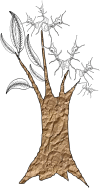Ecological strategies of (pl)ants: Towards a world-wide worker economic spectrum for ants
- PMID: 37056633
- PMCID: PMC10084388
- DOI: 10.1111/1365-2435.14135
Ecological strategies of (pl)ants: Towards a world-wide worker economic spectrum for ants
Abstract
Current global challenges call for a rigorously predictive ecology. Our understanding of ecological strategies, imputed through suites of measurable functional traits, comes from decades of work that largely focussed on plants. However, a key question is whether plant ecological strategies resemble those of other organisms.Among animals, ants have long been recognised to possess similarities with plants: as (largely) central place foragers. For example, individual ant workers play similar foraging roles to plant leaves and roots and are similarly expendable. Frameworks that aim to understand plant ecological strategies through key functional traits, such as the 'leaf economics spectrum', offer the potential for significant parallels with ant ecological strategies.Here, we explore these parallels across several proposed ecological strategy dimensions, including an 'economic spectrum', propagule size-number trade-offs, apparency-defence trade-offs, resource acquisition trade-offs and stress-tolerance trade-offs. We also highlight where ecological strategies may differ between plants and ants. Furthermore, we consider how these strategies play out among the different modules of eusocial organisms, where selective forces act on the worker and reproductive castes, as well as the colony.Finally, we suggest future directions for ecological strategy research, including highlighting the availability of data and traits that may be more difficult to measure, but should receive more attention in future to better understand the ecological strategies of ants. The unique biology of eusocial organisms provides an unrivalled opportunity to bridge the gap in our understanding of ecological strategies in plants and animals and we hope that this perspective will ignite further interest. Read the free Plain Language Summary for this article on the Journal blog.
Keywords: ants; ecological strategy; functional trait; leaf economic spectrum; plant traits; trade‐off; worker economic spectrum.
© 2022 The Authors. Functional Ecology published by John Wiley & Sons Ltd on behalf of British Ecological Society.
Conflict of interest statement
There is no conflict of interest.
Figures




References
-
- Adler, F. R. (1999). The balance of terror: An alternative mechanism for competitive trade‐offs and its implications for invading species. The American Naturalist, 154, 497–509. - PubMed
-
- Andersen, A. N. (1991). Parallels between ants and plants: Implications for community ecology. In Huxley C. R. & Cutler D. F. (Eds.), Ant–plant interactions. Oxford University Press.
-
- Andersen, A. N. (1995). A classification of Australian ant communities, based on functional groups which parallel plant life‐forms in relation to stress and disturbance. Journal of Biogeography, 22, 15–29.
-
- Andersen, A. N. (2019). Responses of ant communities to disturbance: Five principles for understanding the disturbance dynamics of a globally dominant faunal group. Journal of Animal Ecology, 88, 350–362. - PubMed
-
- Anderson, C. , & McShea, D. W. (2001). Individual versus social complexity, with particular reference to ant colonies. Biological Reviews, 76, 211–237. - PubMed
LinkOut - more resources
Full Text Sources
Miscellaneous
